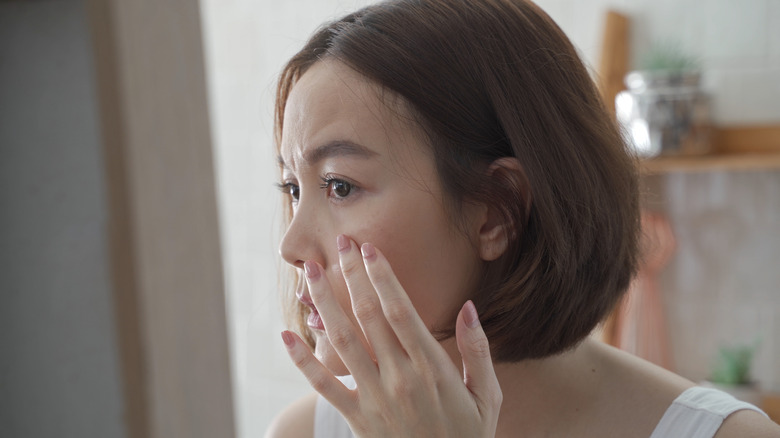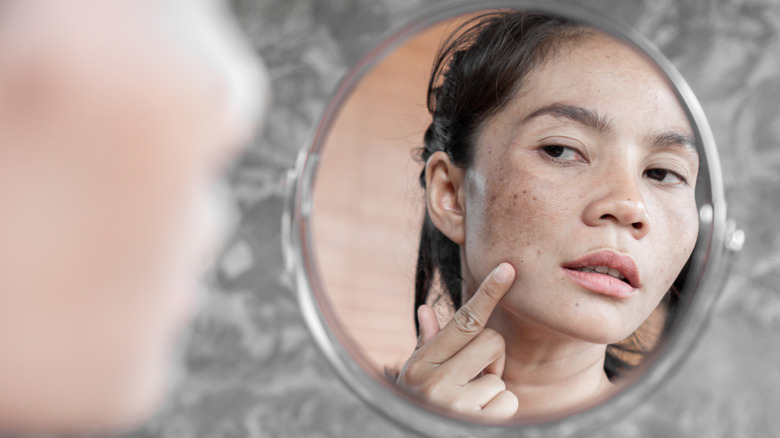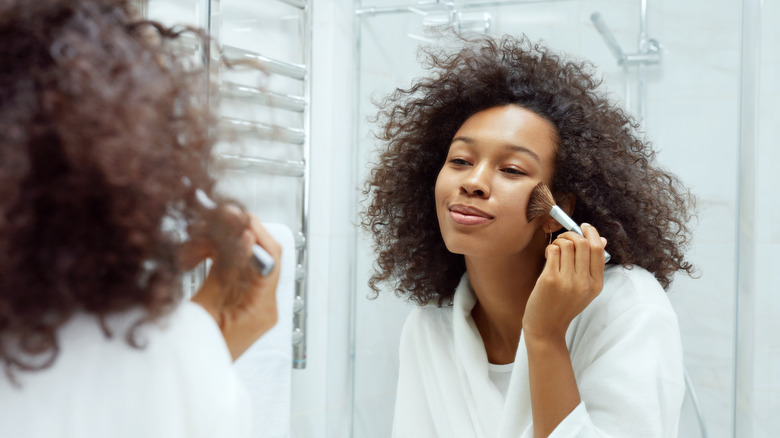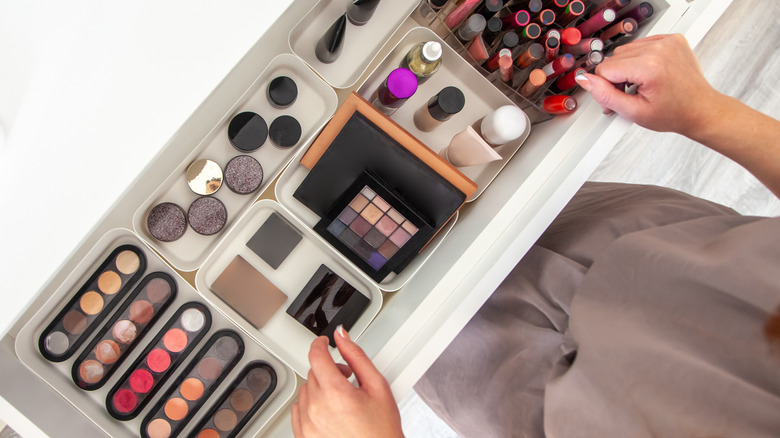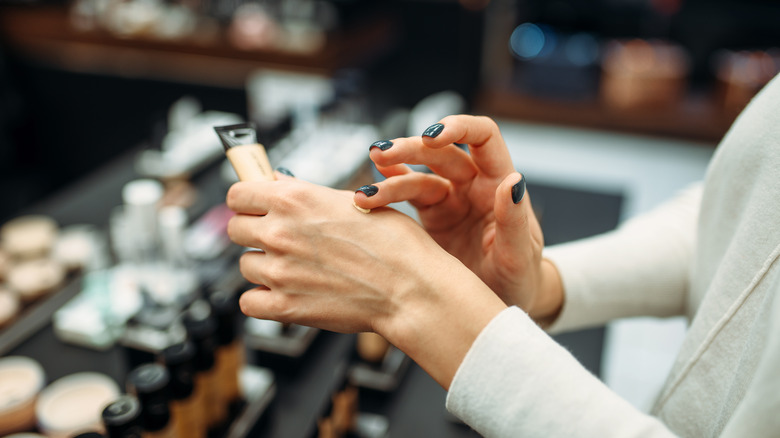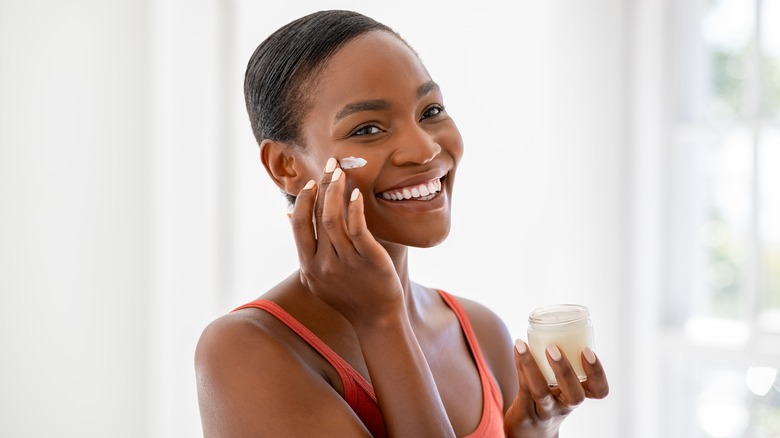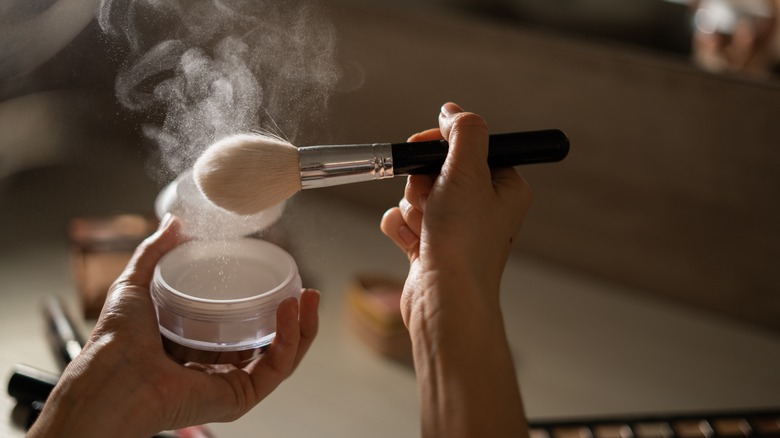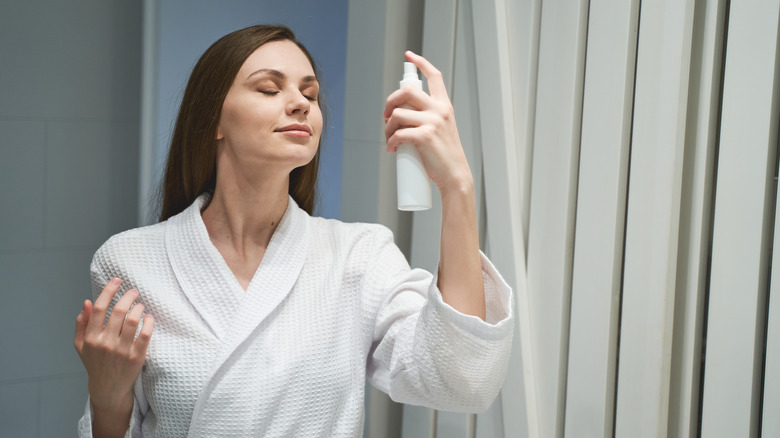7 Reasons Your Makeup Is Separating & How You Can Fix The Mess
We've all been there — you finally finish your glam for the day, sprinkle on a bit of setting powder, and give yourself one last check in the mirror. Everything looks good, and you're feeling confident, but the moment you glimpse yourself in the bathroom later in the day, you realize that something is off. Suddenly, your once-smooth complexion is riddled with patchy spots, texture, and unexpected oil. Don't worry — your skincare routine didn't suddenly fail you, and it's likely just your foundation or concealer separating with wear.
While this phenomenon is annoying, it doesn't mean there's anything to worry about. Even the most experienced makeup artists have likely fallen victim to their bases deciding to betray them suddenly as they went about their days. While separated makeup is sometimes the result of the product itself, it usually comes down to application methods and layering, meaning you'll likely be able to find a fix — no additional product purchases are necessary.
Your skin is oily
Getting your makeup to last and look fresh all day can be a struggle for people with oily or combination skin. After a few hours, oil from your face begins to build up and disrupt the products sitting on the surface, either in your T-zone or throughout the rest of your base. If this is your skin type, you can use a few methods to fight oily skin and decrease your sebaceous glands' production throughout the day.
Before applying your cosmetics, consider reaching for a cleanser designed for oily skin that will leave you with a fresh, clean feeling, then follow up with a gentle astringent toner. Next, you will want to use a lightweight moisturizer that completely soaks into the skin — no heavy creams necessary. Finally, try layering a matte primer under your makeup, then follow up with your favorite setting powder for oily skin. Keep it on hand for touch-ups throughout the day, or toss some blotting papers into your bag to fight oil and the subsequent foundation separating.
You applied too much foundation at once
Here at Glam, we love a full beat, but it's important to take it slow to get the coverage you desire from your foundation without it separating throughout the day. If you apply a thick layer of foundation and then set it with powder, it won't have time to dry and set into the skin properly, especially if you're using a more full-coverage formula. Instead, start with a thin layer for your base. Apply with a brush or beauty sponge to help you soak up extra product, then give it a minute or two to settle.
After this, if you need more coverage, you can go in with your concealer or another thin layer of foundation in the areas where you feel you need it. Once satisfied, you can set it with your powder of choice. Think of it like applying coats of nail polish — if you go in with a thick swipe, it takes longer to cure the nail, leaving you with annoying texture and bumps the second you try to use your hands. With several thin coats and a bit of patience, however, you're left with a flawless manicure — or foundation that lasts, even through a full work day or night out.
Your primer and foundation have different formulas
For the average beauty consumer, it's rare to check the exact formulation of cosmetic products, and instead, we go for what they promise to do. A pore-filling primer layered under a glowy foundation formula sounds like a recipe for a seamless, healthy look, but, as it turns out, certain products don't mix well. According to Maybelline, about three common primer formulas used on the face contain different ingredients — matte primers, illuminating primers, and hydrating primers.
Mixing a matte primer that contains silicone to create a smooth, blurred look with a foundation that also contains the same ingredients likely won't leave you with any issues, but the problem arises when you decide to mix and match. Using that same primer with a water-based, more glowy foundation is like trying to mix oil and water — instead of interacting to create a smooth look, these two products will naturally pull away from one another. To avoid this, keep your products in the same family, or take a look at the ingredients label to ensure they're a compatible combination.
You're using the wrong type of foundation
Ensuring that your foundation and primer are a well-paired duo is necessary to create a long-lasting look, but your foundation choice should also align with your skin type. Foundation formulas are far from one-size-fits-all, and finding one that pairs well with your personal skincare concerns can help prevent issues with the foundation separating before they even start. Just because something is popular and has solid reviews doesn't mean it's a guaranteed fit for your unique skin.
Take, for example, the recent popularity of more natural, glowy looks and glazed donut skincare. If you have dry or normal skin, foundations with added shimmer or hydrating ingredients can be a great option to up that youthful sheen. However, if your skin is oily, it might leave you feeling highly reflective and separate after a few hours of wear. Instead, stick with something matte, and incorporate a powder highlighter to get the same look with more staying power.
You're skipping out on skincare
Regardless of your skin type and level of oil production, it's important to prioritize your skincare before your beauty routine if you want your makeup to last. The products we use on our skin allow us to even out any extremes we face, like dry or oily spots, and provide a smooth, debris-free base for cosmetic products to rest on top of. Makeup separation is commonly seen on oily skin, thanks to the additional moisture interacting with products. However, dry skin can also cause issues with longevity and induce flaky, patchy foundation spots.
To combat this, exfoliate according to your skin type, find a cleanser that works for you, and incorporate an easily-absorbed moisturizer in your morning routine. Before applying makeup, you want your skin to feel clean and smooth, but that also doesn't mean you should layer up with an entire cabinet of products. For most people, a simple morning routine of a gentle cleanser, moisturizer, and sunscreen creates a solid base without annoying pilling or the feeling of heavy products — save the thick creams and intense ingredients like retinol for nighttime.
You applied products in the incorrect order
One of the most fun aspects of makeup application is that there are no set rules, and you're free to play around with whatever textures, colors, and placements your heart desires. Still, regarding the order of application, a few guidelines can help guarantee that your products are working to their fullest potential, for example, applying your cream and liquid products before setting them with powder.
Liquid and cream products were designed to sit directly on the skin — or directly over the top of a primer — so applying powder first can cause issues like pilling, patchiness, and, of course, separation. This is less common to see when it comes to regular foundations as most people learned to apply then set, but it's essential to keep this order in mind if you plan to use mineral or powder foundation alongside other cream products. Instead of applying your powder foundation and contouring, lay and blend your cream products and go over the top with the foundation, similar to the TikTok makeup trend of underpainting.
You haven't properly set your face
Once you complete your makeup look, it's time to lock everything down. Thanks to the uptick in glowy makeup looks, many people are shying away from setting powders to maintain their skin's sheen and avoid cakiness. Still, this step is essential for long-lasting, separation-free makeup. To properly set dry or normal skin while maintaining a natural look, only hit the areas where your skin gets the oiliest — the forehead, nose, and chin — then finish off with a setting spray to melt your products together. For those with oily skin, follow the same steps, but feel free to add a light dusting of powder to the rest of the face to eliminate any extra oil.
After following these steps, you'll be sure to left with a base that won't budge, separate, or slide around throughout the day — even during the most hot and humid months of the year. Flawless makeup is within reach — all it takes is a bit of customization to ensure your products reach their maximum potential.
